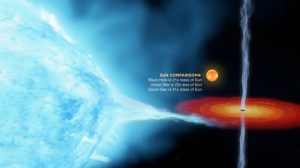The first black hole ever discovered in our Galaxy is part of the high-mass X-ray binary Cygnus X-1. This system consist of two components, the blue giant star HD 226868 and a black hole. Previously, the distance was thought to be around 6100 lightyears, which indicated that the black hole has a mass of around 14 solar masses.
However, a new distance measurement published this week in Science, suggests that the distance to Cygnus X-1 actually is higher than previously thought. Scientists from the Remeis-Oberservatory were involved in this new discovery as well. Using the Very Long Baseline Array, a group of radio telescopes spread across the US, the parallax of the binary system was measured. Due to the Earths movement around the sun, nearby stars seem to move compared to distant galaxies. This movement is called the parallax, with more distant objects showing smaller movements. Using this method, the distance to Cygnus X-1 was now determined to be 7200 lightyears. This has implications on the masses of the components of the system, which are in fact higher than previously assumed.

Artist’s impression of the X-ray binary Cygnus X-1. The black hole can be seen on the left and the blue giant companion on the right. The sun is shown for comparison. © International Centre for Radio Astronomy Research
The new distance suggests a black hole mass of about 20 solar masses, which makes Cygnus X-1 the most massive black hole known to exist in an X-ray binary.
This exciting discovery gives new insight into the formation of black holes. Stellar mass black holes are produced by the death of a massive star, called Supernova. The massive progenitor stars are thought to lose a lot of mass throughout their life time due to strong stellar winds. However, in order to produce a black hole as it exists in this system, the winds had to be weaker than assumed and the progenitor star must have had a mass of ~60 solar masses.
Further information:
- FAU press release (DE)
- Original publication in Science: Cygnus X-1 contains a 21–solar mass black hole—Implications for massive star winds
- Youtube: CYGNUS X-1: the most massive black hole near to Earth
For more information contact:
Jörn Wilms
Joern.Wilms@sternwarte.uni-erlangen.de
+49 9131 85-81013




